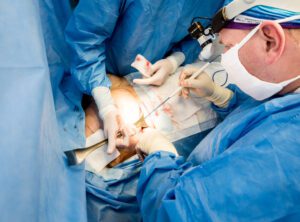An increasing number of women are electing to have their breast implants surgically removed without any plans of implant replacement. If you have been considering having explant surgery (breast implant removal surgery), here’s how it’s done, what you can expect, and what your options are post-removal.
Why are people removing breast implants? Explant surgery is on the rise – and for reasons that are understandable. There are many motives a  woman would wish to have her implants removed and not replaced. The same devices that once brought her satisfaction and contentment toward her body image may have overstayed their welcome in more cases than one and she may simply want to rid her body of the extra baggage. Most notably, women have their breast implants removed due to concerns or complications commonly associated with BII (Breast Implant Illness) or breast implant-associated anaplastic large-cell lymphoma (BIA-ALCL). Other reasons may include capsular contracture, ruptures, leaks, and aesthetic reasons, such as weight loss or gain due to pregnancy or breastfeeding. Also, implants do not come with a lifetime guarantee, as patients are highly advised to consider replacing or removing their implants between 10 and 15 years. While many women will replace their implants, many will not. According to the American Society of Plastic Surgeons (ASPS), over 36,000 individuals had their implants removed, an 8% increase from 2021.
woman would wish to have her implants removed and not replaced. The same devices that once brought her satisfaction and contentment toward her body image may have overstayed their welcome in more cases than one and she may simply want to rid her body of the extra baggage. Most notably, women have their breast implants removed due to concerns or complications commonly associated with BII (Breast Implant Illness) or breast implant-associated anaplastic large-cell lymphoma (BIA-ALCL). Other reasons may include capsular contracture, ruptures, leaks, and aesthetic reasons, such as weight loss or gain due to pregnancy or breastfeeding. Also, implants do not come with a lifetime guarantee, as patients are highly advised to consider replacing or removing their implants between 10 and 15 years. While many women will replace their implants, many will not. According to the American Society of Plastic Surgeons (ASPS), over 36,000 individuals had their implants removed, an 8% increase from 2021.
Removing Breast Implants and Lift
Because of the unmistakable, visible laxity and “deflated” look of the breast skin post-implant removal surgery, most patients will opt to undergo a lift (mastopexy) upon their implant removal procedure. Here, excess, loosened skin is removed, and the breast tissue is reshaped for a more symmetrical, perkier, youthful-looking pair. In some cases, the nipple and areola are repositioned. Breast implant removal surgery with a lift is a very common procedure for women not seeking to replace their breast implants.
Other Types of Breast Implant Removal Surgery
Whether a patient is seeking to remove silicone breast implants, remove saline breast implants, remove textured breast implants, or remove breast implants with reconstruction, there are specific procedures that take place for each. Patients are medically and physically evaluated to determine the best course of action for explant surgery that will suit them best and help them realize their aesthetic goals. The following are other types of breast implant removal surgery:
- Removing Silicone Breast Implants – The goal of the explant surgery is to remove the breast implants from a previous augmentation or reconstructive surgery. Most times, only the silicone implant is extracted from the breast area, including all silicone material and leakage. However, in some cases, the surgeon will also remove the breast capsule, or scar tissue that forms after the breast implants are placed (capsulectomy). If the scar tissue that has formed doesn’t cause the patient disfigurement or discomfort, the surgeon will leave the harmless scar tissue in place.
- Removing Saline Breast Implants – Removal of saline implants requires a “deflation by needle” technique. The saline solution is extracted through a needle that is inserted through a small incision made in the skin where implants are deflated and removed. The remaining capsule often shrinks down, becoming residual scar tissue.
- Removing Textured Implants – Though controversial, the FDA elected NOT to ban the use of textured implants in May 2019 due to an increase in BIA-ALCL cases. Though there was an increase in BIA-ALCL cases amongst women with textured implants, some women with smooth implants have also been afflicted with BIA-ALCL. Interestingly, unless the patient has experienced fluid collection or a mass has been detected, removal of textured implants is not recommended.
- Removing Breast Implants and Reconstruction – Gone are the days when a woman needs to depend on foreign devices to enjoy a more shapely and fuller feminine figure. Also referred to as a tissue/flap reconstruction, this specific technique naturally restores the appearance, volume, and symmetry of the breasts post-implant removal. Tissue is taken from other body parts, such as the belly, buttocks, back, or thighs to help reconstruct and sculpt the breast region. The breast silhouette is beautifully refurbished and enhanced without the use of foreign entities that may cause complications down the line and is a preferred choice amongst many patients. However, not all patients have enough tissue from other body parts to achieve their breast goals, so an evaluation will need to be conducted.
How Long Does It Take to Heal from Breast Implant Removal Surgery?
 If a patient undergoes a straightforward explant surgery without an accompanying reconstruction or lift, their road to recovery may take as little as 6 weeks or as long as a year for most symptoms to resolve (swelling, bruising, tenderness, redness, etc.). Like any surgical or cosmetic procedure, recovery can vary from patient to patient. Refraining from lifting and rigorous activity is recommended, though most patients can resume school or work within a week or two. However, those with more physically demanding professions may have to wait an additional few weeks before they’re able to return to work. Most patients will follow up with their doctor at the six-week mark for evaluation of post-op progress and additional steps.
If a patient undergoes a straightforward explant surgery without an accompanying reconstruction or lift, their road to recovery may take as little as 6 weeks or as long as a year for most symptoms to resolve (swelling, bruising, tenderness, redness, etc.). Like any surgical or cosmetic procedure, recovery can vary from patient to patient. Refraining from lifting and rigorous activity is recommended, though most patients can resume school or work within a week or two. However, those with more physically demanding professions may have to wait an additional few weeks before they’re able to return to work. Most patients will follow up with their doctor at the six-week mark for evaluation of post-op progress and additional steps.
If you have undergone breast augmentation or reconstructive surgery using breast implants and have been contemplating removing your breast implants without any plans for implant replacement, we invite you to reach out to our conveniently located Beverly Hills office to speak with any one of our highly knowledgeable staff members. We can address any questions and/or concerns you may have, including the different, signature techniques offered by leading breast specialist Dr. Barrett. If you believe you are experiencing symptoms associated with BII, we urge you to seek medical attention immediately.
Do you want to learn more about Barrett Plastic Surgery? Keep up to date by subscribing to our blog and following us on social media at Twitter, TikTok, Instagram, Realself, YouTube, Snapchat, Yelp, and Facebook for updates.

